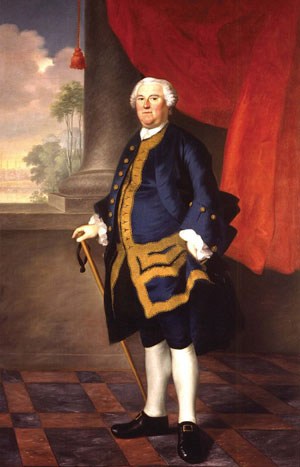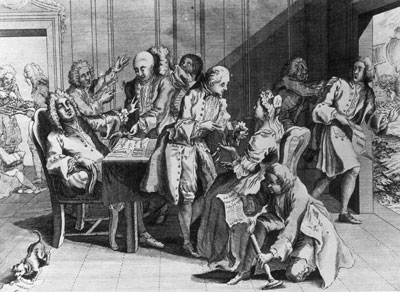By Russell Bastedo, Wentworth-Coolidge Commissioner & retired NH State Curator

When Benning Wentworth graduated from Harvard College (Class of 1715), Europe was at the start of a unique 25-year period of peace in Europe. The wars between alliances of Catholic and Protestant states that had been a constant since the 1532 creation of the Church of England by Britain’s King Henry VIII had stopped, due to financial exhaustion, and peace ensued. The Catholic powers led by King Louis XIV of France (1638-1715; monarch 1643-1715) had bankrupted themselves by following France into the War of Spanish Succession (1701-1714). France was itself financially exhausted, having fought a disastrous series of wars against the Dutch for control of the seas in the 1670s, and then having led her fellow Catholic states into a series of battles against Britain’s Lord Marlborough and his Protestant allies in a series of fiscally disastrous annual conflicts fought on mainland Europe, 1700-1710.
With a cessation of hostilities Britain was able to consolidate its hold on British North America, and to expand its holdings there by extracting territory from France after every military victory. From Newfoundland in the north[1] to Jamaica in the south[2], British North American coastal trade was controlled by the British Navigation Acts of 1650/1, by which all imports and exports to and from British North America were to be made in British-owned and British- manned vessels. British North American merchants thrived with the lack of competition from other European countries, and with Jamaica to the south they were able to bargain surreptitiously for goods with the Dutch, the Spanish and other landholders in the Caribbean.
British North America’s population was small and predominantly rural at the time of Benning Wentworth’s 1715 graduation from Harvard College. The most important port in terms of size was Boston, the midpoint for shipping between Newfoundland and Jamaica; Boston’s population grew from 7,000 in 1690 to 12,000 in 1720, with some 750 warehouses in the town. The second major port was Philadelphia (population 4,000 in 1690, 10,000 in 1720); then New York (population 3,900 in 1690, 7,000 in 1720); Newport (population 2,600 in 1690, 3,800 in 1720); and Charles Town, in Carolina (population 1,100 in 1690, 3,500 in 1720.[3] [From 1730-1750 the colonial population of British North America increased from 629,000 to 1,170,000 (and then to 2,148,000 in 1770). The numbers of slaves in the colonies numbered about 236,000 in 1750, almost triple the number of slaves in 1720; numbers of slaves almost doubled, 1750- 1770.[4]] The British North American colonies concentrated on shipping raw products to the Mother Country, and on their coastal trade; all manufactured goods came from Great Britain in British-owned and British-manned ships.
Benning Wentworth fit easily into the import-export market at Portsmouth, New Hampshire, exporting work animals and foodstuffs to the Caribbean “sugar islands”, and timber, dried fish and other New Hampshire products to his agent in London. Benning Wentworth’s imports almost certainly included rum, Spanish olives, and other European products available in the Caribbean, plus manufactured goods imported from Britain. His credit-debit accounts were kept in London, and his London purchases offset with his exports to the Mother Country. It was a stable world, with a minimum of disruptions from piracy and privateers, or losses at sea due to fire or other catastrophe.
And then suddenly the world changed. The trigger was Spain, which had been forced to sign a 30-year trade agreement (asiento ) with Britain at the end of the War of Spanish Succession (1714). By terms of the agreement British interests had a 30-year ‘window’ (1714-1744) in which to sell an unlimited number of slaves to Spain’s “sugar islands”. The trade was immensely profitable to the Royal African Company, and at the end of the period Britain continued its slave trade, and threatened the overthrow of Spanish colonial governments throughout the Caribbean. In response Spanish forces began to board English ships, and to capture English ships’ crews, in an effort to preserve their empire.
In Britain the response of major business interests in Parliament was to seek war with Spain. Seeking a cause for a declaration of war, the pro-war legislators brought Robert

Jenkins, a London beggar, into the House of Commons to tell his story. Jenkins’ story, told to passers-by for years on the London streets, was that he had been a British seaman who had lost his ear when Spanish forces had boarded his ship and tortured the crew. Jenkins carried a shriveled ear in a small box as proof of his torture; the House of Commons roared its anger; and on March 24, 1738 the House of Commons petitioned King George II to seek redress. The King did not resist, and the British military began to plan for what became the War of Jenkins’ Ear.[5]
Preparing for war with Spain proceeded slowly, because there was fear that France would enter the war in defense of her Spanish ally. King Louis XIV of France had died; no one knew how King Louis XV (1710-1774; monarch 1715-1774) would react. British preparations for war proceeded cautiously. Not until July 23, 1739 did Vice Admiral Edward Vernon and a squadron of ships sail from England to Port Royal, Jamaica. When they were in place the First Minister to His Majesty’s Government ,Sir Robert Walpole, issued a formal declaration of war, and Vice Admiral Vernon’s fleet attacked and captured (within forty-eight hours) Porto Bello, Panama.
Emboldened by this easy victory (commemorated with the naming of London’s Portobello Road and the composing of the patriotic song “Rule, Britannia!”) the British government decided that Vernon should continue his Caribbean campaign. But the government also recognized that a much greater land and sea force were needed for a wider campaign. The British North American colonies would have to build additional ships, and provide 30,000 men to the war effort.
This news of quotas and ships assessed by the British government on British North America came as a considerable shock to the British North American colonies. Virginia was the largest colony, and it was able to provide 3,000 men from the militia for the war effort. But even in 1730s Virginia the colonial militia was stretched thin along the western borders, trying to protect the Tidewater Virginia tobacco economy from the French and their Native American allies. Giving 3,000 men as their quota to the war effort was an effort Virginia could ill afford. George Washington, then a child (1732-1799), saw his elder half brother Lawrence, a member of the Virginia colonial militia, apply for and receive a royal commission as an officer in the expeditionary force from Royal Governor Gooch[6], and other members of the Virginia planter class sought the same. But in other colonies smaller populations had great difficulty meeting British demands.
The long years of peace and prosperity without war had also persuaded colonial legislatures to forego budgeting for upgrades in their defenses. From the 1713 Treaty of Madrid the colonies had had peace; now the threat of naval war coming from France and/or her allies, coupled with danger on the western frontiers, greatly alarmed the colonies’ populations. In Connecticut, for example, the legislative Assembly had not budgeted for war, and at New London, the colony’s most important seaport, the town voted on June 26, 1744 to have their selectmen address a petition for protection directly to King George II. The petition said in part:
…we shall probably have twenty, thirty, or perhaps fifty vessels at a time, laden mostly with provisions, belonging to this and neighboring governments, waiting for convoy, and have not anything to defend such fleet from your majesty’s enemies but a battery of seven guns (some of which are very unfit for service)…. [7]
And Vice Admiral Vernon’s expanded mission did not go well. Lawrence Washington returned home in mid-1742, a survivor of a campaign that had been racked by disease, a lack of supplies, and the loss of 30,000 men and 120 ships out of 180 ships.[8] Throughout British North American colonies there was suffering, and resentment that the British government had not even consulted with them before going to war. In Britain Sir Robert Walpole was forced to retire from office.
The Spanish had asked King Louis XV of France for protection against Britain in the late 1730s, after their 1713 thirty-year trade concession to Britain, made in the 1713 Treaty of Madrid, had been violated. France had offered support to her Spanish ally. And France decreed in 1738 that from then on ships entering the Caribbean would be French ships only; the British Navigation Acts would no longer be in force. A French challenge to the British-controlled African slave trade had been made. And throughout British North America merchants in the coastal trade saw Spanish customers refuse to pay their bills now that war had been declared.
Benning Wentworth of New Hampshire was one of the British North American merchants who faced economic ruin in the new landscape confronting British North America in the War of Jenkins’ Ear. And if Benning Wentworth failed at business, so would many of his English backers and friends of his family.
By good fortune, discussions concerning New Hampshire’s emergence as a Royal British North American colony were well under way, and in 1741 King George II confirmed New Hampshire’s new status. Thanks to his English connections Benning Wentworth in 1741 became the first Royal Governor of New Hampshire, as well as Surveyor of His Majesty’s Woods in North America. Without the War of Jenkin’s Ear New Hampshire might well have remained a part of Massachusetts, without Royal Governor Benning Wentworth (governor 1741-1767) in charge. Governor Wentworth was aided by history. But the War of Jenkins’ Ear, a war fought for control of the slave trade and begun in the British Parliament’s arrogance that expanded into a major British military defeat, turned out to be the start of French-British hostilities that would last for the rest of the 18th century. Britain’s loss of British North America, the bankruptcy and then end of the French monarchy, and the creation of a new nation – the United States of America – were only a few of the results emanating from the War of Jenkins’ Ear.
[1] Britain’s King Charles I gave Newfoundland’s southern peninsula to Lord Baltimore as a proprietorship in 1616. Lord Baltimore created “Ferryland” as a refuge for English Catholics. British ownership of Newfoundland was confirmed by a British-French treaty signed in 1713, in the wake of Lord Marlborough’s military victories over France.
[2] Jamaica was captured from Spain in 1655 by Britain’s Lord Cromwell. The 1670 Treaty of Madrid confirmed British ownership of Jamaica; soon afterward the Britain’s Royal African Company was formed, and Jamaica became one of the world’s greatest markets for West African slaves.
[3] Carl Bridenbaugh, Cities in the Wilderness: Life in Urban America, 1625-1742 (1938, 1966), Chapter V, “The Expanding Scene”.
[4] Richard Hofstadter, America at 1750: A Social Portrait (1971), Chapter 1, “Population and Immigration”, 6.
[5] Christopher Hill, The Century of Revolution, 1603-1714 (1961), 262-265. See also Brandon Harris, “The War of Jenkins’ Ear” (Wikimedia Foundation, Inc., 2011).
[6] Douglas S. Freeman, George Washington: A Biography (1948), vol. 1, 65ff.
[7] Francis M. Caulkins, History of New London, 1612-1860 (1895), 390.
[8] Freeman op cit.
